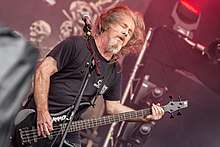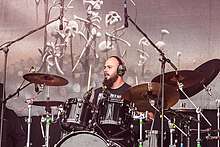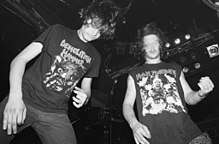Demolition Hammer
Demolition Hammer is a thrash metal band from the Bronx, New York. The band formed in 1986 and released three full-length albums between 1990 and 1994. Century Media Records made a complete anthology available in 2008. After a 21-year hiatus, Demolition Hammer reformed in 2016.
Demolition Hammer | |
|---|---|
 Demolition Hammer at Party.San Metal Open Air 2017 | |
| Background information | |
| Origin | The Bronx, New York, U.S. |
| Genres | Thrash metal |
| Years active | 1986–1995, 2016–present |
| Labels | Century Media |
| Members | Steve Reynolds James Reilly Derek Sykes Angel Cotte |
| Past members | John Salerno Dennis Munoz Vinny Daze Alex Marquez Mike Usifer |


History
Formation and first two albums (1986–1992)
Demolition Hammer arrived on the East Coast thrash metal scene circa 1986. The original line-up consisted of Steve Reynolds as the vocalist and on bass, James Reilly on guitar, and John Salerno on drums. Their first demo tape, Skull Fracturing Nightmare, was released in 1988. It gained notice from fans of the genre and independent record labels. Derek Sykes was brought in as a second guitarist and Vincent Civitano (a.k.a. Vinny Daze) replaced Salerno. Their second demo, Necrology, secured the group a recording contract with Century Media Records.[1]
Their first album, Tortured Existence, was produced by Scott Burns with a small budget. The songs were composed with fast riffs, chunky breakdowns, and expressive guitar solos. In 1992, the band released their critically acclaimed album Epidemic of Violence. The production was clearer and included faster and leaner songs.[2] The covers of these first two releases featured horror based artwork[3] and a logo designed by Daze.
Time Bomb and breakup (1993–2015)

Fast-paced thrash metal became less popular in the '90s. Daze and Reilly left the band to form the group Deviate NY. Former Malevolent Creation drummer Alex Marquez joined Reynolds and Sykes to write material for another project. The label wished to release the songs with the band's original name. The result was the 1994 album Time Bomb with a new Demolition Hammer logo on the cover. It was slower and lacked guitar solos. The style was similar to that of groups like Pantera and Machine Head.[1][2] After playing one of their final shows at Milwaukee MetalFest in the summer of 1995, Demolition Hammer broke up.[4]
Marquez and Reynolds were offered new gigs with Solstice.[1] Daze died of globefish poisoning while traveling in Africa on March 11, 1996.[5] With Demolition Hammer's music becoming increasingly hard to come by, Century Media released Necrology: A Complete Anthology in 2008. It included every title from their first three albums, two pre-production demos from Time Bomb, and one video clip.[2]
Reunion (2016–present)
In March 2016, the band reunited with new drummer Angel Cotte. They played a show in June 2016 in Brooklyn, New York for which it was sold out under 3 minutes.[6] They also played that year's Maryland Deathfest.
In a January 2017 interview at 70000 Tons of Metal, the members of Demolition Hammer were asked if the band will record a follow-up to 1994's Time Bomb. Bassist and vocalist Steve Reynolds replied, "We've talked. But we were so busy just trying to work all this in, we haven't really solidified any plans for that. But we're still talking about it." Guitarist James Reilly added, "Now that we see how well this is going, we do have it in our heads to start writing some new material and see where it goes."[7]
Musical style
In reference to a national tour in 1991, it was written that Demolition Hammer played "lightning-fast songs with complex structure and shifting rhythms."[8] Another writer referred to Reynolds and Sykes as "riff machines"[2] while also complimenting the band's songwriting ability. The band's sound is generally considered a fusion of thrash metal and death metal. The change of style towards a groove metal sound heard on Time Bomb drew ire from some fans of thrash metal.[2]
Members
- Steve Reynolds – bass, vocals (1986–1995, 2016–present)
- James Reilly – guitar, backing vocals (1986–1993, 2016–present)
- Derek Sykes – guitar, backing vocals (1988–1995, 2016–present)
- Angel Cotte – drums (2016–present)
- Former
- John Salerno – drums (1986–1988)
- Vinny Daze – drums, backing vocals (1988–1993; died 1996)
- Alex Marquez – drums (1994–1995)
- Touring Members
- Dennis Munoz – guitar (1995)
- Mike Usifer - guitar, backing vocals (1992)
Timeline

Discography
Studio albums
- Tortured Existence (Century Media, 1990)
- Epidemic of Violence (Century Media, 1992)
- Time Bomb (Century Media, 1994)
Compilations
- Necrology: A Complete Anthology (Century Media, 2008)
Demos
- Skull Fracturing Nightmare (1988)
- Necrology (1989)
References
| Wikimedia Commons has media related to Demolition Hammer. |
- Rivadavia, Eduardo. "Demolition Hammer". Billboard. Retrieved August 17, 2010.
- Bergman, Keith. "CD reviews; Demolition Hammer Necrology: A Complete Anthology (Century Media)". Roadrunner Records. Archived from the original on October 28, 2008. Retrieved August 17, 2010.
- Mudrian, Albert (2009). Precious Metal: Decibel Presents the Stories Behind 25 Extreme Metal Masterpieces. Da Capo Press. p. 104. ISBN 978-0-306-81806-6.
- "Demolition Hammer Concert Setlist at Milwaukee Metalfest IX on July 28, 1995". setlist.fm. Retrieved February 21, 2017.
- Simmonds, Jeremy (2008). The Encyclopedia of Dead Rock Stars: Heroin, Handguns, and Ham Sandwiches. Chicago Review Press. p. 363. ISBN 978-1-55652-754-8.
- "Demolition Hammer". facebook.com. Facebook. Retrieved 19 March 2016.
- "Reunited DEMOLITION HAMMER Is 'Talking About' Making New Studio Album". Blabbermouth.net. February 21, 2017. Retrieved February 21, 2017.
- "City Limits". The Pittsburgh Press. July 7, 1991. p. G4. Retrieved August 17, 2010.